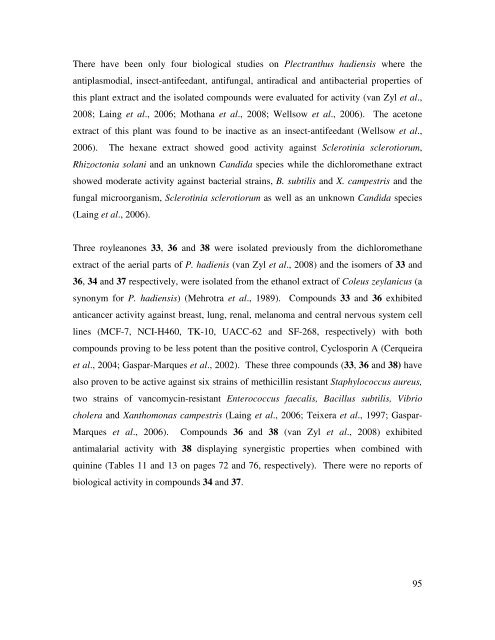university of kwazulu-natal faculty of science and agriculture school ...
university of kwazulu-natal faculty of science and agriculture school ...
university of kwazulu-natal faculty of science and agriculture school ...
You also want an ePaper? Increase the reach of your titles
YUMPU automatically turns print PDFs into web optimized ePapers that Google loves.
There have been only four biological studies on Plectranthus hadiensis where the<br />
antiplasmodial, insect-antifeedant, antifungal, antiradical <strong>and</strong> antibacterial properties <strong>of</strong><br />
this plant extract <strong>and</strong> the isolated compounds were evaluated for activity (van Zyl et al.,<br />
2008; Laing et al., 2006; Mothana et al., 2008; Wellsow et al., 2006). The acetone<br />
extract <strong>of</strong> this plant was found to be inactive as an insect-antifeedant (Wellsow et al.,<br />
2006). The hexane extract showed good activity against Sclerotinia sclerotiorum,<br />
Rhizoctonia solani <strong>and</strong> an unknown C<strong>and</strong>ida species while the dichloromethane extract<br />
showed moderate activity against bacterial strains, B. subtilis <strong>and</strong> X. campestris <strong>and</strong> the<br />
fungal microorganism, Sclerotinia sclerotiorum as well as an unknown C<strong>and</strong>ida species<br />
(Laing et al., 2006).<br />
Three royleanones 33, 36 <strong>and</strong> 38 were isolated previously from the dichloromethane<br />
extract <strong>of</strong> the aerial parts <strong>of</strong> P. hadienis (van Zyl et al., 2008) <strong>and</strong> the isomers <strong>of</strong> 33 <strong>and</strong><br />
36, 34 <strong>and</strong> 37 respectively, were isolated from the ethanol extract <strong>of</strong> Coleus zeylanicus (a<br />
synonym for P. hadiensis) (Mehrotra et al., 1989). Compounds 33 <strong>and</strong> 36 exhibited<br />
anticancer activity against breast, lung, renal, melanoma <strong>and</strong> central nervous system cell<br />
lines (MCF-7, NCI-H460, TK-10, UACC-62 <strong>and</strong> SF-268, respectively) with both<br />
compounds proving to be less potent than the positive control, Cyclosporin A (Cerqueira<br />
et al., 2004; Gaspar-Marques et al., 2002). These three compounds (33, 36 <strong>and</strong> 38) have<br />
also proven to be active against six strains <strong>of</strong> methicillin resistant Staphylococcus aureus,<br />
two strains <strong>of</strong> vancomycin-resistant Enterococcus faecalis, Bacillus subtilis, Vibrio<br />
cholera <strong>and</strong> Xanthomonas campestris (Laing et al., 2006; Teixera et al., 1997; Gaspar-<br />
Marques et al., 2006). Compounds 36 <strong>and</strong> 38 (van Zyl et al., 2008) exhibited<br />
antimalarial activity with 38 displaying synergistic properties when combined with<br />
quinine (Tables 11 <strong>and</strong> 13 on pages 72 <strong>and</strong> 76, respectively). There were no reports <strong>of</strong><br />
biological activity in compounds 34 <strong>and</strong> 37.<br />
95

















